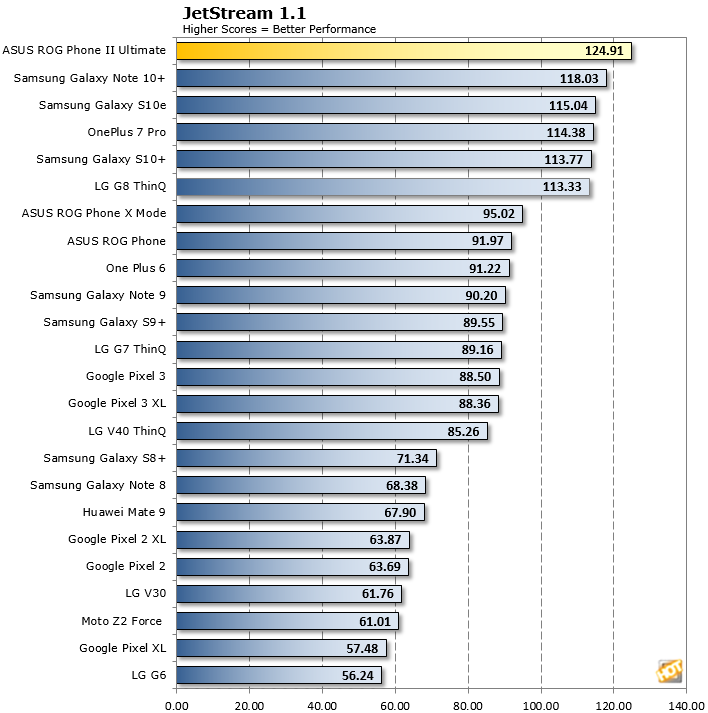ASUS ROG Phone II Benchmark Preview: The Fastest Android Phone Ever
ASUS recently sent us its brand-spanking-new ROG Phone II and we are in the process of evaluating the handset for a full review. We hope to have that posted within the next few weeks. In the meantime, we have some preliminary benchmarks and initial analysis to share, starting with the observation that this is the fastest Android phone we have ever tested. More on that in a moment.
Before we get into the initial performance data, let's take a moment to talk about the gaming phone category, the ROG Phone II Ultimate Edition, and the specs.
Gaming phones are still a somewhat new and niche category, albeit a growing one. ASUS threw its hat into the ring last year with its first generation ROG Phone, a handset we found to be an excellent phone for both gaming and general usage. We found it was well designed and fast, with features that were largely useful rather than gimmicky.
For the second generation model, ASUS is upping the ante with some key upgrades. For one, the 6.59-inch AMOLED display (2340x1080) now supports a 120Hz refresh rate (and 1ms response time), up from the previous model's 90Hz cap. That puts it on par with the 120Hz panel on the Razer Phone 2, though ASUS is the first to feature an AMOLED screen at that refresh rate, on a mobile device. It's also a 10-bit panel with HDR support.
Under the hood, ASUS is running with a Qualcomm's flagship Snapdragon 855+ processor. The specially-binned SoC sports an octa-core CPU clocked at 2.96GHz, paired with an overclocked Adreno 640 GPU that can boost its performance up to 15 percent above spec. A generous 12GB of RAM (up from 8GB in the previous model) and up to 1TB of storage (ROG Phone II Ultimate Edition has 1TB, our device is the Elite at 512GB) rounds things out.


ASUS ROG Phone II System Specs
One other thing that sets this phone apart from the competition is an X Mode, a feature that has been carried over from the previous model.
"X Mode raises the minimum CPU frequency and optimizes both the memory and game-data processing
performance, allowing you to dedicate all the systems performance to your game. X Mode will also
prevent RAM-eating and battery-sapping app activity, based on a customizable list of apps," ASUS explains.
As with the previous generation model, ASUS bundles a special cooling apparatus with the ROG Phone II. This snaps on the back of the phone and provides active cooling, with direct airflow targeting the hottest part of the phone's rear cover. According to ASUS, this can lower surface temperatures by up to 3.5C, and bolster performance. It's also intended to help thwart sweaty palms.
"Dry skin means you can keep a surer grip on the ROG Phone II as you charge towards victory," ASUS says.
ASUS ROG Phone II Benchmarks - The Fastest Android Phone We've Ever Tested
So, this thing is a beast on paper. What about in practice? Well, we ran some preliminary benchmarks with X Mode enabled, and grabbed some numbers. Let's have a look...

We kicked things off with Jetstream, a JavaScript benchmark suite focused on web application performance. Here we see the ROG Phone II shoot to the top of the chart, skipping ahead of Samsung's flagship Galaxy Note 10+ and Galaxy S10+, and devices like the OnePlus 7 Pro. We also see a wide gap in performance compared to last year's ROG Phone model, which we also benchmarked in X Mode.

Things are a little closer in Geekbench, though the ROG Phone II Ultimate still manages to leave all other Android handsets behind. Interestingly, Apple's iPhone XS Max still leads the charge, and that's a device that is about to be supplanted by the iPhone 11 Pro Max.

The ROG Phone II records another clean sweep in AnTuTu, both in the individual subsets (CPU, GPU, memory, and UX) and the overall score.

When we switch our focus to graphics performance, the ROG Phone II shows us more of the same—it leads every other Android phone we have ever tested, though slots in below in the iPhone XS Max.

In 3DMark's Sling Shot Extreme test, the ROG Phone II again tops the chart. In the overall score, it's around 9.5 percent faster than the Galaxy Note 10+, and around 55 percent faster than last year's ROG Phone model. Those are some impressive gains.
Summed up, the ROG Phone II is looking like a worthy successor the first-gen model, and one heck of a fast Android device in its own right. We will have more benchmarks and plenty of additional analysis to share in our forthcoming full review.
* Note 9/12/19 - This article was updated to reflect that we have an ASUS ROG Phone II Elite model here for testing, with 512GB of storage, and not the ROG Phone II Ultimate with 1TB of storage, though performance should not vary between models.
* Note 9/12/19 - This article was updated to reflect that we have an ASUS ROG Phone II Elite model here for testing, with 512GB of storage, and not the ROG Phone II Ultimate with 1TB of storage, though performance should not vary between models.





